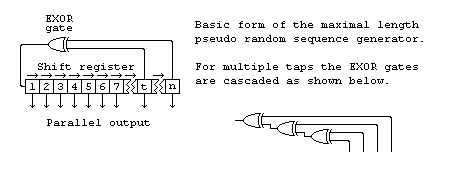![[Return to top]](../../epc.png)
6502 pseudo random number generator. By Lee Davison
[Back]
This is a short peice of code that generates a maximal length, 8 bit, pseudo random number sequence. This is the 6502 version of Z80 random. A 32 bit 68k version can be found here.Other number lengths.This routine is no great shakes in the speed stakes, it's just a demo of a usefull technique.
A maximal length pseudo random number generator is basically just a shif register with feedback from the later stages to generate the next input bit. The form for a generator of length n with feedback from t is shown below.

You don't have to limit the length to only 8 bits, any number of bits from two upwards will work if you chose the right feedback tap(s). Here is a table of some values.
Bits [n] Tap(s) [t] Length Bits [n] Tap(s) [t] Length 2 1 3 3 2 7 4 3 15 5 3 31 6 5 63 7 6 127 8 6,5,4 255 9 5 511 10 7 1023 11 9 2047 15 14 32767 16 15,13,4 65535 17 14 131071 18 11 262143 20 17 1048575 21 19 2097151 22 21 4194303 23 18 8388607 24 23,22,17 16777215 25 22 33554431 28 25 268435455 29 27 536870911 31 28 2147483647 In the last case, with 31 bits, if you took a new value once a second the sequence wouldn't repeat for over sixty eight years. Even clocked at 1MHz it would still take almost a minute and a half to cycle through every state.
A sequence generator like this is used to generate values for the RND() function in EhBASIC.
![[e-mail]](../../eml_sm.png)